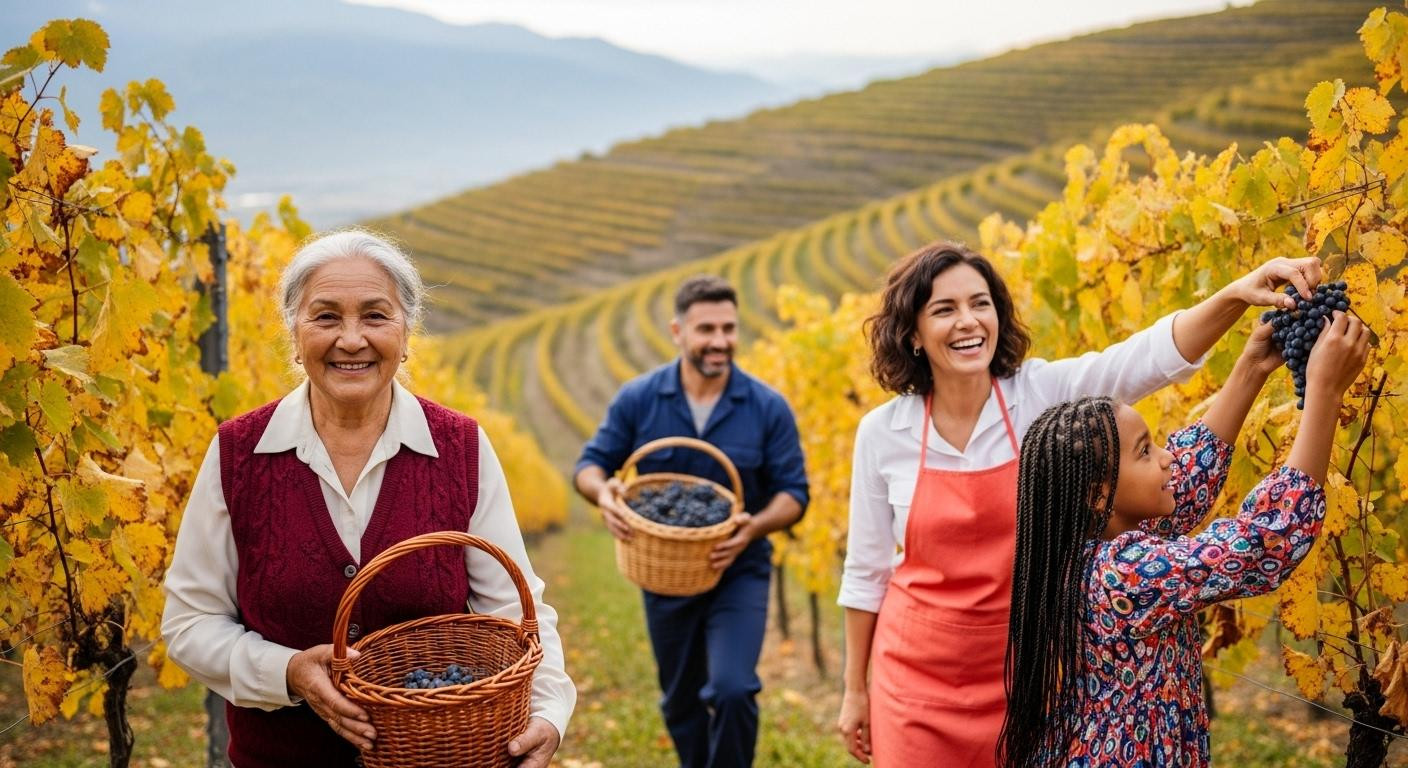Dawn breaks at 6:50 AM over Sighnaghi’s ancient city walls as September mist lifts from the Alazani Valley. Below, 320,000 Kakheti residents begin Rtveli, the grape harvest ritual older than written history. While Tuscany’s commercialized wine tours charge tourists $40 for structured tastings, Georgia’s 8,000-year-old traditions unfold in communal grape-picking, ancient Qvevri cellars, and polyphonic singing that echoes through vineyard valleys. This is the harvest festival locals quietly protect, not from tourists, but from commercialization.
The morning air carries scents of crushed grapes and wildflowers. Temperature drops from summer’s 91°F heat to ideal 68°F harvest conditions. Families gather in vineyard rows carrying woven baskets unchanged since ancestral times.
The morning Kakheti residents wait for all year
September light transforms golden vineyards into a living cathedral. Alaverdi Monastery’s 10th-century bells signal harvest time across the valley. Vineyard terraces cascade toward snow-capped Caucasus peaks 50 miles distant.
The sensory atmosphere overwhelms visitors immediately. Mountain air scented with fermenting wine mingles with earth and wildflowers. Unlike Tuscany’s structured wine experiences, Georgia’s harvest unfolds organically around family traditions.
Locals gather in multigenerational groups at sunrise. The silence before collective work begins creates a sacred pause. Eight thousand years of tradition prepares to unfold again.
What 8,000 years of unbroken winemaking preserves
Georgia earned its designation as the “Cradle of Wine” through archaeological evidence. No other region can claim continuous winemaking spanning eight millennia. The revelation strikes visitors witnessing traditions unchanged since 6000 BCE.
The Qvevri cellars tourists rarely see
UNESCO-recognized clay vessel fermentation creates Georgia’s distinctive wine character. Alaverdi Monastery’s underground cathedral houses 2-meter Qvevri buried for temperature stability. Candlelit stone arches preserve techniques monks maintained for 1,000 years.
Visitors touch clay aged by centuries. They taste wine drawn directly from vessels using traditional goatskin scoops. The tactile experience connects them to winemaking’s earliest origins.
The supra feast that defines community
Traditional Georgian supra transcends mere dining. Long communal tables stretch under open skies during harvest celebrations. The tamada leads polyphonic singing between courses of Khachapuri, Satsivi, and Mtsvadi paired with estate wines.
Strangers become family through shared harvest celebration. Toasts honor ancestors who picked the same vines for 300 generations. The emotional weight rivals France’s most authentic vineyard experiences.
The Rtveli experience guidebooks don’t describe
Real participation begins at 7:00 AM before heat becomes unbearable. Joining local families requires no special skills, only willingness to learn.
Grape-picking at dawn with local families
Traditional basket-weaving techniques pass between generations during harvest work. Elderly women teach songs sung during Soviet occupation, Ottoman rule, and Persian invasions. Visitors learn distinguishing Saperavi from Rkatsiteli grapes by touch alone.
Communal grape-stomping transforms tourists into participants in living archaeology. Feet crush fruit as ancestors did for 300 generations. The physical engagement creates immediate connection to Georgia’s wine soul.
What locals eat during harvest
Field lunches prepared by grandmothers feature fresh Churchkhela made from the day’s pressing. Homemade bread bakes in traditional tone ovens. Estate cheese ages in Qvevri brine. Young wine, partially fermented juice sweet and effervescent, accompanies every meal.
Full-day Rtveli experiences cost $130-150 including transport, tastings, and meals. This contrasts sharply with commercialized harvest tourism elsewhere, where similar experiences exceed $200 per person.
The transformation wine can’t measure
Standing in Sighnaghi at sunset reveals the valley’s true character. Over 50 wineries light windows across the landscape. Visitors understand why 519,000 annual wine tourists experience Georgia differently than Tuscany or Bordeaux.
The weight of 8,000 years isn’t marketed or commodified. It lives daily through 320,000 residents whose families survived empires by fermenting grapes in buried clay. Rtveli isn’t tourism but invitation into survival transformed into celebration.
Harvest becomes sacred act connecting past, present, soil, and stranger. The authenticity rivals hidden Mediterranean gems without the crowds or premium pricing.
Your questions about Georgia’s wine valleys answered
When is Rtveli and can tourists participate?
Rtveli occurs September-October depending on grape variety ripening. Most wineries welcome visitors during harvest through organized tours costing $130-150 for full-day experiences including transport, tastings, meals, and grape-picking. Book 2-3 months in advance as experiences sell out quickly. Smaller family estates offer spontaneous participation if you arrive during harvest week.
How does Georgian wine culture differ from European traditions?
Qvevri underground clay fermentation creates distinctive orange wines with deeper tannins and earthier profiles than French or Italian methods. Winemaking connects to Orthodox Christianity with harvest blessed by priests. Family estates outnumber corporate vineyards. Wine culture intertwines inseparably with food, toasting rituals, and polyphonic singing traditions.
Is Kakheti worth visiting over Tuscany or Napa?
For authenticity and value, absolutely. Accommodation costs 40-60% less than comparable regions, ranging $50-120 versus $150-300 elsewhere. Wine tastings cost $5-15 versus $30-50 in established destinations. Cultural depth remains unmatched through participation in the world’s oldest continuous winemaking tradition. Trade-offs include fewer luxury amenities, rougher roads, and language barriers outside Tbilisi.
Morning mist lifts from Alaverdi’s stone walls as a grandmother pours freshly pressed Saperavi into clay cups her great-grandmother used. Polyphonic voices rise through vineyard rows older than empires. This is the soul of the Caucasus, not photographed or commodified, but lived in harvest light that transforms strangers into witnesses of eternity.
